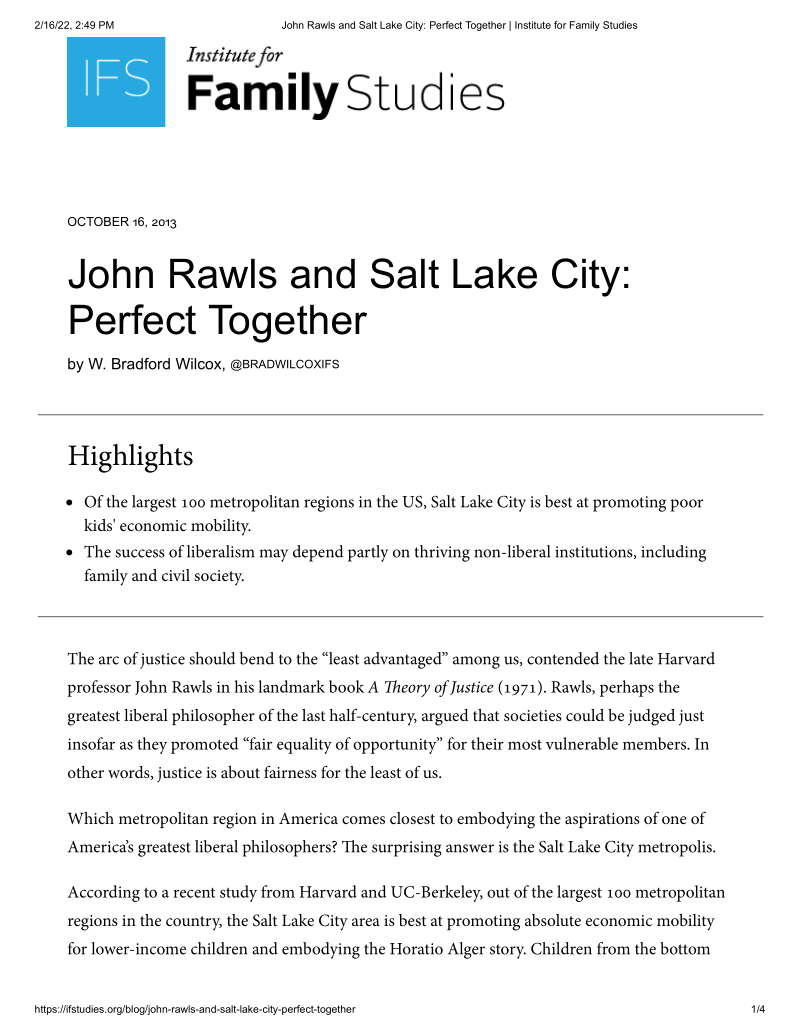W. Bradford Wilcox discusses the link between Salt Lake's civil society and economic mobility.
- Type
- Website
- Source
- Bradley R. Wilcox Non-LDS
- Hearsay
- Secondary
- Reference
W. Bradford Wilcox, "John Rawls and Salt Lake City: Perfect Together," Institute of Family Studies blog, October 16, 2013, accessed February 16, 2022
- Scribe/Publisher
- Institute of Family Studies
- People
- Bradley R. Wilcox
- Audience
- Reading Public
- Transcription
The arc of justice should bend to the “least advantaged” among us, contended the late Harvard professor John Rawls in his landmark book A Theory of Justice (1971). Rawls, perhaps the greatest liberal philosopher of the last half-century, argued that societies could be judged just insofar as they promoted “fair equality of opportunity” for their most vulnerable members. In other words, justice is about fairness for the least of us.
Which metropolitan region in America comes closest to embodying the aspirations of one of America’s greatest liberal philosophers? The surprising answer is the Salt Lake City metropolis.
According to a recent study from Harvard and UC-Berkeley, out of the largest 100 metropolitan regions in the country, the Salt Lake City area is best at promoting absolute economic mobility for lower-income children and embodying the Horatio Alger story. Children from the bottom 20% of the national income distribution in the Salt Lake City region were more likely to “reach the top 20% of the national income distribution” as adults than poor children hailing from any other major metropolitan region in America.
What accounts for the area’s success? The study does not specifically focus on Salt Lake’s comparative advantage for kids, but it does suggest two factors that are key to fostering income mobility for children around the United States: family and civil society. Specifically, the Harvard-Berkeley study that the New York Times called the “most detailed portrait of income mobility in the United States” found that the most powerful (negative) correlate of such mobility was the share of single moms in a region. This means that children were most likely to realize the American dream when they came from regions—like the Salt Lake City area—with comparatively strong families. Utah, for instance, has some of the lowest rates of nonmarital childbearing and highest shares of its adult population married of any state.
Likewise, the study also found that the strength of a region’s civil society was strongly correlated to economic mobility. Communities rich in social capital and religiosity, for instance, were more likely to foster economic mobility for children. And Utah is one of the most religious states in the country, and it scores high on national indices of social trust. Accordingly, the study provides strong prima facie evidence that the Salt Lake City metro success story may be attributed in part to its robust civic life.
- Citations in Mormonr Qnas
The B. H. Roberts Foundation is not owned by, operated by, or affiliated with the Church of Jesus Christ of Latter-day Saints.

